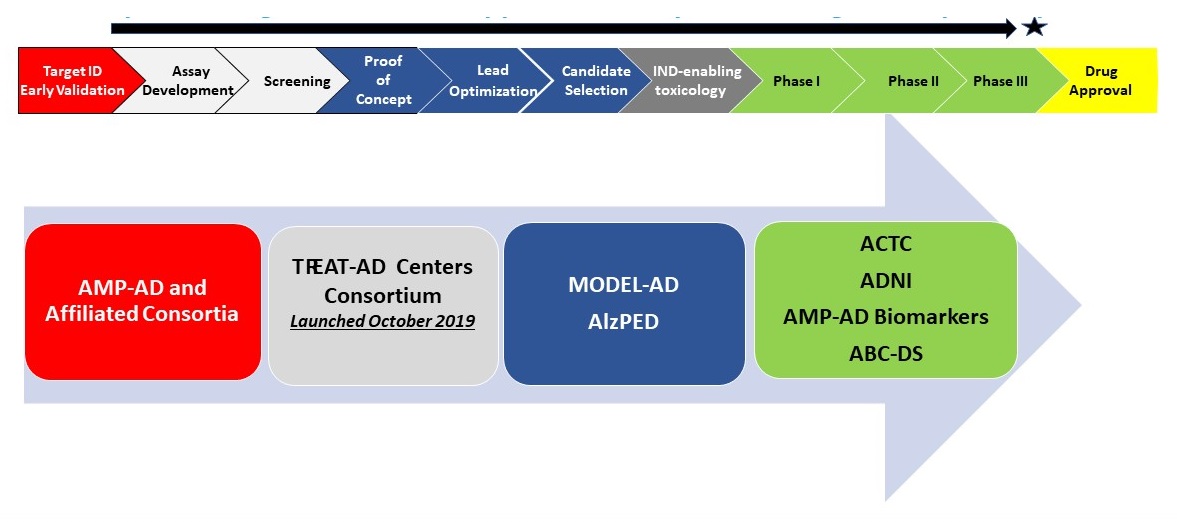Monday, January 27, 2020
Printer Friendly Version in PDF Format (8 PDF pages)
Alzheimer's Disease and Related Dementias Research Update
Richard J. Hodes, M.D.
Director, NIA
FY 2020 Budget- Funding Increases Across the Board
- $41.7 Billion for the NIH
- $500M for All of Us
- $500M for BRAIN
- $60M for Down Syndrome
- $350M increase for AD/ADRD ($2.8B total)
- $3.54B for the NIA
- $110.3M increase for non-targeted NIA research
- All divisions will benefit
- DBSR
- DGCG
- DAB
- DN
NIA AD/ADRD Appropriations
- 2011
- National Alzheimer's Project Act (NAPA)
- 2012
- $50 M* redirected within NIH budget
- 2013
- $40 M* redirected within NIH budget
- 2014
- $100 M additional approp
- 2015
- $25 M additional approp
- 2016
- $350 M additional approp
- 2017
- $400 M additional approp
- 2018
- $414 M additional approp
- 2019
- $414 M additional approp
- 2020
- $350M in additional appropriations as of 12/20/19
*one-year money
Years displayed are Fiscal Years
NIH Funding for AD/ADRD Research -- in millions
From NIH's Research, Condition, and Disease Categories (RCDC) System
| Research/Disease Areas (Dollars in millions and rounded) |
FY 2015 | FY 2016 | FY 2017 | FY 2018 | Difference -- FY18 to FY15 |
|---|---|---|---|---|---|
| AD/ADRD | $631 | $986 | $1,423 | $1,911 | 3.0-fold increase |
| Alzheimer's Disease | $589 | $929 | $1,361 | $1,789 | 3.0-fold increase |
| Alzheimer's Disease Related Dementias[1] | $120 | $175 | $249 | $387 | 3.2-fold increase |
| Lewy Body Dementia | $15 | $22 | $31 | $38 | 2.5-fold increase |
| Frontotemporal Dementia | $36 | $65 | $91 | $94 | 2.6-fold increase |
| Vascular Cognitive Impairment/Dementia | $72 | $89 | $130 | $259 | 3.6-fold increase |
|
|||||
NIA AD Translational Research Program: Diversifying the Therapeutic Pipeline
| Multiple funding mechanisms support each step of the drug development process | |||
|---|---|---|---|
 |
|||
| Multiple funding mechanisms support each step of the drug development process | |||
|---|---|---|---|
 |
|||
| https://www.nia.nih.gov/news/nih-funded-translational-research-centers-speed-diversify-alzheimers-drug-discovery | |||
Active NIA AD/ADRD and Related Intervention and Prevention Trials (~230)
- 37 Early-stage Clinical Drug Development (Phase I and Phase II Clinical Trials)
- Amyloid (10)
- Receptors (2)
- Neuroprotection (6)
- Metabolism and Bioenergetics (2)
- Vasculature (3)
- Growth Factors and Hormones (2)
- Multi-target (1)
- Inflammation (2)
- Oxidative Stress (2)
- Other (7)
- 9 Late-stage Clinical Drug Development (Phase II/III and Phase III Clinical Trials)
- Amyloid (6)
- Neuroprotection (2)
- Vasculature (1)
- 108 Non-Pharma-cological Interventions
- Exercise (23)
- Diet (8)
- Cognitive Training (23)
- Assistive Tech. (13)
- Sleep (4)
- Combination Therapy (11)
- Other (26)
- 8 Clinical Therapy Development for the Neuro-psychiatric Symptoms of AD/ADRD
- Pharmacological (5)
- Non-Pharmacological (3)
- 67 Care and Caregiver Interventions
- Improving Care for PWD (26)
- Improving care provided by family or informal caregiver (41)
https://www.nia.nih.gov/research/ongoing-AD-trials
Behavioral and Social Research on Alzheimer's Disease and Related Dementias
 |
 |
AD/ADRD Epidemiology Initiatives at NIA
- Funding Opportunity Announcements
- Major Opportunities for Research in Epidemiology of AD/ADRD and Cognitive Resilience
- Active until November 13, 2021
- Centers on the Demography and Economics of AD/ADRD
- Recently closed- earliest project start date April 2020
- High-Priority Behavioral and Social Research Networks in AD/ADRD
- Two projects recently awarded
HRS Family Studies Around the World

https://hrs.isr.umich.edu/data-products The Healthy Cognitive Aging Project (HCAP) Dementia Assessment in HRS-Family Studies
- The now-global consortium of studies (HRS-sister studies) collecting rich cognitive data using the Harmonized Cognitive Assessment Protocol
- https://hrs.isr.umich.edu/data-products/cognition-data
Dementia Care, Caregiving, & Services Summit
- Save the Date
- March 24-25, 2020
- Natcher Conference Center, Bethesda, MD
- Registration open now!
- https://www.nia.nih.gov/2020-dementia-care-summit
NIH's 2nd Inclusion Across the Lifespan Workshop
- Save the Date
- September 2-3, 2020
- Natcher Conference Center NIH Main Campus, Bethesda, MD
- A Request for Information (RFI) open until February 15, 2020
- https://grants.nih.gov/grants/guide/notice-files/NOT-OD-20-044.html
- Major Opportunities for Research in Epidemiology of AD/ADRD and Cognitive Resilience
